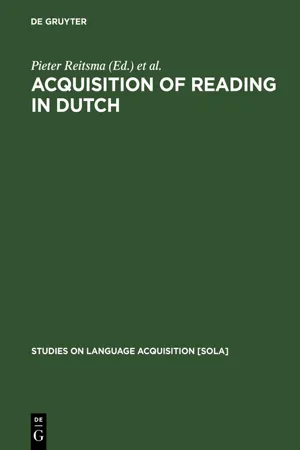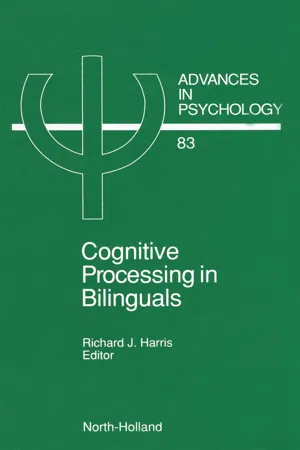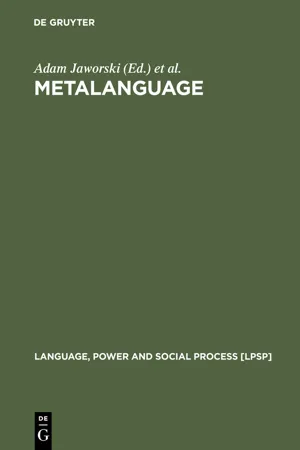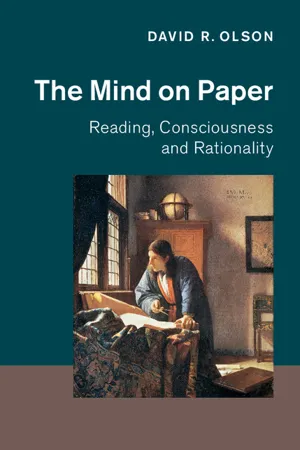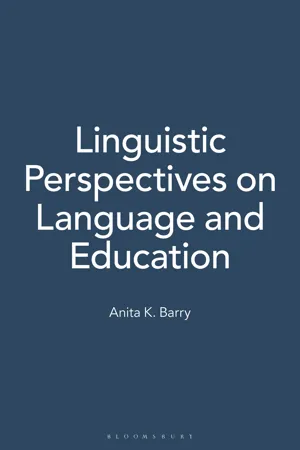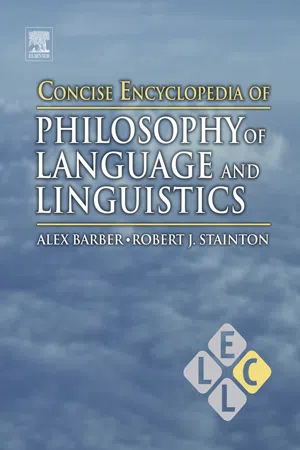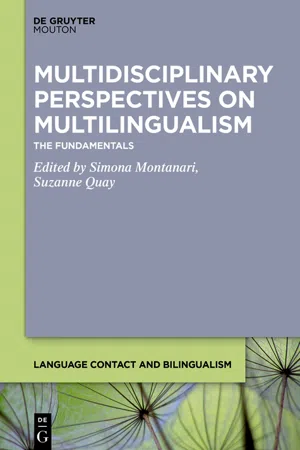Languages & Linguistics
Metalinguistics
Metalinguistics refers to the study of language itself, including its structure, usage, and meaning. It involves analyzing and discussing language as a system, as well as examining how language is used to talk about language. This field of study is concerned with understanding the nature and functions of language, as well as how it is used and interpreted by speakers and listeners.
Written by Perlego with AI-assistance
Related key terms
1 of 5
10 Key excerpts on "Metalinguistics"
- Karen Roehr, Gabriela Adela Ganem-Gutierrez(Authors)
- 2013(Publication Date)
- Bloomsbury Academic(Publisher)
Such understanding is grounded in a functionalist view of language, where the essence of human communication is symbolization and meaning making in specific contexts (Tomasello, 2003). L2 development is not only about communicative abilities, but also about internalizing conceptual meanings with functional relevance in communicative contexts. In the L2 classroom, the development of functional and sophisticated understandings of language is not necessarily part of learning activity. The potential for the development of sophisticated and coherent conceptual categories in adult L2 teaching and learning is always a possibility. However, instruction that is based on incomplete presentations or explanations, unsystematic representations of grammatical knowledge or lack of properly organized and guided conceptual reflection by learners does not lead to development of coherent and complete conceptual understandings. Metalinguistic knowledge and the L2 classroom From a teaching/learning perspective, metalinguistic knowledge, metalanguage terms (constructs to explain or talk about language) and grammatical rules (language to describe regularities in morphosyntax and language use), are beneficial for classifying words in a language and for describing basic uses of linguistic features. However, not all metalanguage contains metalanguage terms. Rules of grammatical use do not always need grammatical categories. In most university contexts, metalinguistic knowledge is used by teachers and studied by learners in L2 grammar manuals and textbooks. Metalinguistic knowledge used in L2 metalanguage grammars is mostly based on ideas whose origins can be The Being and Becoming of Metalinguistic Knowledge 227 traced to grammarians from classical antiquity. Dyonisus Trax is credited with articulating the canonical categories for classifying words into different kinds (noun, pronouns, adjectives, verbs, adverbs, prepositions, conjunctions) (Odlin, 1994, p. 7).- eBook - PDF
- Pieter Reitsma, Ludo Verhoeven, Pieter Reitsma, Ludo Verhoeven(Authors)
- 2016(Publication Date)
- De Gruyter Mouton(Publisher)
3 Metalinguistic Awareness and Learning to Read Martin Mommers In general, language development may be thought of in terms of two qualitatively different, though related, achievements. The first is the development of primary linguistic skills, i.e., understanding and producing language. The second is the emergence of metalinguistic skills, the ability to reflect consciously upon the nature and properties of language. It is an important aspect of our unique capacities as human beings that we can not only act, but also reflect on our actions; not only can we learn and use language, we can also treat it as an object of analysis and observation in its own right. Metalinguistic awareness is a special kind of language performance, one which makes special cognitive demands, and seems to be less easily and less universally acquired than speaking and listening. According to Bertelson (1986) metalinguistic abilities include detection of structural and lexical ambiguities, appreciation of linguistic jokes, segmentation of words into phonemes and of sentences into words. Moreover, they include separation of words from their referents, judgement of the semantic and grammatical well-formedness of word strings, detection of inconsistencies and communication failure. Tunmer and Bowey (1984) argue that the kind of mental functioning involved in metalinguistic operations underlies four types of metalinguistic ability. They propose a psychological model of sentence comprehension, which provides the basis for classifying the various manifestations of metalinguistic awareness. Four broad categories are postulated: phonological awareness, word awareness, form awareness and pragmatic awareness. Phonological and word awareness refer to the awareness of the units of spoken language: phonemes and words. - eBook - PDF
- I. Kurcz, G.W. Shugar, J.H. Danks(Authors)
- 2009(Publication Date)
- North Holland(Publisher)
Metalinguistic knowledge is composed of the knowledge and capacities that do not seem to be directly linked to comprehension and production processes; it implies examining language as an object of knowledge, rather than using it as a communicative tool. In some sense, the subject is called upon to dissociate meaning from form, to be able to examine both in- dependently. In short, we are dealing here with categorical o r abstract knowledge about language (its structure and use), which permits the subject not only to llknowll and lldiscusslT lan- guage as an object, but which a l s o enables him to perform cer- tain language-related tasks (such as segmenting the vocal stream into words o r explaining the meaning of a metaphor) that are different from simply producing o r comprehending speech. This definition is rather vague. It does not permit us to decide with certainty if a particular activity is to be classed as llproductionll o r as evidence for metalinguistic knowledge1'. For example, if a child says, 1 goed to the store, I went to the storeT1, is he simply repeating himself with some variation (something we all do often without being particularly aware of anything at all), or is he explicitly showing us that he real- izes that llgoedT1 is an incorrect generalization of a grammati- cal rule, and that the correct form is llwentll? (See Kaper, 1959, Metalinguistic Knowledge and Language Development 61 1 p. 129, for a discussion of the status of self-corrections.) We will never be able to decide: certain activities may be on the borderline between llproduction and comprehension and lin- guistic awareness, o r both types of activities may be involved at the same time. (The problem is compounded by the fact that one must use language as a communication medium to access the subject's knowledge of language.) Similarly, the question of different levels of knowledge creates a problem. - eBook - PDF
- R.J. Harris(Author)
- 1992(Publication Date)
- North Holland(Publisher)
In other words they use formal linguistic knowledge with a communicative purpose. Similarly Sorace found it difficult to explain why the subjects in her study showed a growing interaction between their metalinguistic knowledge and their productive use of the target language if the function of formal knowledge is limited to monitoring. She argues, like Odlin, for a productive function for metalinguistic awareness, which would account for hesitations, self-corrections, and restatement of utterances. Odlin has suggested that there is evidence that the most successful individuals are able to detect errors that especially interfere with discourse comprehension (p. 138). Gass (1983) has similarly noted the facilitative role played by metalinguistic abilities in both learning to communicate and actually communicating: conscious repairs can keep the conversation from failing altogether when break-downs in communication have taken place. In her later work Bialystok (1986) defines metalinguistic ability as an emerging ability that reflects gradual progess with underlying cognitive skills which she refers to as the analysis of knowledge and the control of cognitive operations. As language development takes place so the child structures and organizes an implicit body of language and gradually moves toward representations of knowledge that include explicit features for the structure of that knowledge (p.15). This is what Bialystok means by analysis of language. Control of cognitive operations refers to the degree of intentionality of cognitive processing involved in solving specific problems. In relation to control in language Bialystok argues that as children develop they are freed from focusing on the meaning of language to treat language as a system. In her recent book on communication strategies Bialystok (1990) has developed the concept of analysis of linguistic knowledge and control of linguistic processing as components of language processing. - eBook - PDF
Metalanguage
Social and Ideological Perspectives
- Adam Jaworski, Nikolas Coupland, Dariusz Galasinski, Adam Jaworski, Nikolas Coupland, Dariusz Galasinski(Authors)
- 2012(Publication Date)
- De Gruyter Mouton(Publisher)
Before doing so, how-ever, let me specify two ways of using the term metapragmatics which I want to distance myself from in what follows. Neither of them bears on the reflex-ivity of language itself. The first is metapragmatics in the sense of critical discussions of pragmatics; this belongs to the order of endeavors which any self-respecting scientific discipline has to engage in. According to the second, Met-apragmatics studies the conditions under which pragmatic, i.e., users', rules are supposed to hold (Mey 1993: 277) - a topic which would generally be regarded as the province of pragmatics itself. 4 There is a reason why such con-fusion could arise, but we can only explain that later. First we have to go deeper into the fundamental relationship between pragmatics and metapragmatics. In the following section we will introduce the notion of metapragmatic aware-ness in relation to a general theory of pragmatics, arguing for the central role it plays in any type of language use, thus strengthening the view of metalan-guage as a dimension rather than an object in its own right and demonstrating the relevance - indeed, necessity - of taking metalinguistic or metapragmatic functioning into account when approaching instances of language use. 3. Pragmatics and the central role of metapragmatic awareness This section is formulated against the background of a theory of linguistic prag-matics which defines language use as the adaptable and negotiable making of linguistic choices, both in production and in interpretation, from a variable (and constantly varying) range of options in an interactive effort at generating mean-ing (see Verschueren 1999). 5 The highly dynamic processes that are involved take place in a medium of adaptability which, rejecting any strict dichotomy between society and cognition, could be labeled mind in society (following Vygotsky 1978). - eBook - PDF
The Mind on Paper
Reading, Consciousness and Rationality
- David R. Olson(Author)
- 2016(Publication Date)
- Cambridge University Press(Publisher)
This is part of the understanding that makes learning possible. This allows us an escape from what looks like a dilemma. Learning to read is not only mastering the practice of reading, it is learning, at the same time, a set of metalinguistic concepts for think- ing and talking about reading. This is the metalanguage shared by parent and child or teacher and child as they talk about what the child is seeing and what is to be seen in the text before her. This met- alanguage is so common as to escape notice, but is involved in every exchange between the child faced by a text and a parent or teacher who is suggesting and monitoring the practices – “That says ‘dog’.” “Says” here is the metalinguistic verb borrowed from everyday lan- guage. The metalanguage develops into a literate metalanguage when concepts like letter and word are introduced to explicitly link proper- ties of speech to properties of the written script. Such metalanguage provides the rules and norms for correct usage (e.g., “That’s not a word”). But it is important to remember that these concepts are about language and reading, they do not constitute the processes, largely implicit and unconscious and increasingly automatic, that readers implement in finding a meaning in a text. Put simply, while metalin- guistic concepts tell readers what to look for, reading is the practical competence in finding and aligning these features to produce a mean- ing. The more concepts available, the more one can see in a text. Renate Valtin (2014) criticized the skills-based approach to teaching literacy by arguing that it is impossible to demonstrate a causal relation between phonological awareness and learning to read. In a re-analysis of earlier studies that had claimed that ability on pho- nemic tasks predicted reading ability, she reported that those children - Anita K. Barry(Author)
- 2002(Publication Date)
- Praeger(Publisher)
For example, defining words or judging whether a sentence is ambiguous or identifying the subject and the predicate of a sentence are all metalinguistic activities. Exercise 2 1. Laws are good examples of decontextualized language. A sign on a res- taurant wall might say No Smoking and convey all the information it needs to in that context. But what would a general law about smoking in restaurants look like? 2. Can you think of examples of metalinguistic activities other than those listed in the preceding paragraph? If you are a teacher, think of some of the language activities in which you engage your students. Also see Sug- gested Project 7 in Chapter 8. If we think about literacy instruction in education, it seems clear that much of our energies are devoted to these three components of literacy: permanence, 238 Linguistic Perspectives on Language and Education decontextuality, and metalanguage. In the early years we focus on teaching the means toward creating and retrieving meaning from a permanent record of lan- guage, namely writing and reading. As children progress, we require the devel- opment of decontextualized language, a sensitivity to the requirements of language removed in time and space from the immediate context in which it is created. At the same time, we ask students to participate in a range of meta- linguistic activities that engage them in conscious analysis of their communi- cation system, often including extensive investigation into the structure of their language. In many ways, we have already said throughout this book how knowledge of linguistics and linguistic perspectives can shape the way we approach these tasks in education. Linguistics gives us a way of understanding what language skills students already possess when they come to school and how they acquired them. It gives us a way to think about the linguistic differences we observe in our classrooms, both in individuals and in groups of students.- Alex Barber, Robert J Stainton(Authors)
- 2010(Publication Date)
- Elsevier Science(Publisher)
All rights reserved. Introduction Linguistics is the study of language, and there are many different kinds of linguistics, some mutually compatible, some in competition. This diversity of approaches to linguistics is possible because language does not present itself to investigation as a coherent and well-defined field of enquiry that is clearly distinct from other areas of investigation. Instead, language is best imagined as a landscape through which it is pos-sible to take various journeys, its horizons redefined by each approach. Most approaches to linguistics agree on a few basic facts about language. The first is the fact of linguistic form. While the status of linguistic form is in dispute (as I show below), it is clear that linguistic events such as utterances or inscriptions must be understood as manifestations of linguistic types. Thus utterances must be understood as tokens of combinations of words, even though it may be impossible to isolate a ‘word’ in the actual stream of sound. The words belonging to classes (such as ‘Noun’) are made by selecting sounds from an inventory of sounds (phonemes of the language) and so on; in all cases, language must be understood as drawing on inven-tories of types and combining those types in regular ways: a word of the type ‘Article’ precedes a word of the type ‘Noun’ in English (within the Noun Phrase). These regularities, another idealization away from the crude data, involve rules or generalizations or constraints. No account of language can ignore the fact that language is ordered and regular, based on an inventory of types and rules of combination that together constitute linguistic form. The second fact accepted by all approaches to linguistics is that form relates to meaning. A central function of language is to enable communication, and the organization of linguistic forms has some relation to the organization of mean-ing.- eBook - PDF
Language Learning and Cognition
The Basics of Cognitive Language Pedagogy. With Contributions by Kees de Bot, Marina Foschi, Marianne Hepp, Sabine De Knop and Parvaneh Sohrabi
- Jorg Roche, Ferran Suñer(Authors)
- 2023(Publication Date)
- LIT Verlag(Publisher)
1.1.6 Summary - Cognitive linguistics distinguishes itself from other approaches by defining language as a means of conceptualizing reality. Reality is fixed by the interaction between individuals in a particular cultural context and acquired through general learning mechanisms. - Cognitive linguistics also assumes that language is a meaningful system of symbolic structures which can be explained using the principles of general cognition and cannot be generated by a fixed set of rules. Among other things, prototype effects, metaphoriza- tion, and polysemy are appropriate for explaining the lexis and the grammar of a language. - Finally, the advantages of a cognition-based language pedagogy can be explained by the cognitive plausibility of language descrip- tion as well as its high compatibility with task-based approaches. 1.1.7 Review Questions 1. What are the major differences between cognitive linguistics and generative linguistics? 2. What is the cognitive commitment in cognitive linguistics? 3. What is a prototype effect and what role does it play in grammar? 4. How would you explain the advantages of cognitive language ped- agogy over traditional language teaching methods? 35 1.2 Language and the Multilingual Brain Kees de Bot Language processing is one of the most complex tasks our brain per- forms. It is a task that requires the cooperation of parts that are connected in a network throughout the entire brain. Some parts are more strongly involved than others. While scientists used to believe that certain lan- guage functions are located in specific brain areas, there is now a con- sensus that no area of the network is solely responsible for language pro- cessing. Still, there are many areas of the network in both hemispheres that are of significance. - eBook - PDF
Multidisciplinary Perspectives on Multilingualism
The Fundamentals
- Simona Montanari, Suzanne Quay, Simona Montanari, Suzanne Quay(Authors)
- 2019(Publication Date)
- De Gruyter Mouton(Publisher)
Another widely used method is that of grammaticality judg-ment tests. While studies on SLA mainly use grammaticality judgment tests to investigate MeLA, research into multilingualism covers a broader range of skills related to metalinguistic awareness, e.g., communicative sensibility, creativity, and flexibility. 15 Cross-linguistic Interaction and Multilingual Awareness 339 Qualitative research employs Think Aloud Protocols (TAP) with introspective and/or retrospective comments to elicit information on processes involved in cross-linguistic word retrieval or text comprehension tasks (cf. Jessner 2006; Jessner and Török 2017). In her introspective study on lexical search in L3 pro-duction, Jessner (2006) also found that XLA and MeLA, tested in the form of explicit meta-language, exerted influence on the activation of the individual languages in the multilingual mental lexicon (see also Jessner, Megens, and Graus 2016). According to Woll (2018), introspective verbal data collected through TAPs complement findings based on language-inherent characteris-tics of CLI. 15.3.5 Studying multilingual awareness from a DMM perspective 15.3.5.1 Multilingual learning in institutional contexts As pointed out above, members of the DyME group at Innsbruck University (www.dyme.uibk.ac.at) carried out a number of studies that focused on the na-ture of cross-linguistic interaction and multilingual awareness. Results consis-tently showed that experienced multilingual learners are specific language learners with a significant advantage in the development of multilingual/meta-linguistic skills in comparison with less experienced learners/users. Hofer (2015) studied the development of MeLA/XLA in 8-and 9-year-old primary school students in South Tyrol comparing pupils in what the re-searcher calls a “ trilingual branch ” with Italian and German as languages of instruction and English as L3 with pupils in a traditional setting, i.e.
Index pages curate the most relevant extracts from our library of academic textbooks. They’ve been created using an in-house natural language model (NLM), each adding context and meaning to key research topics.

